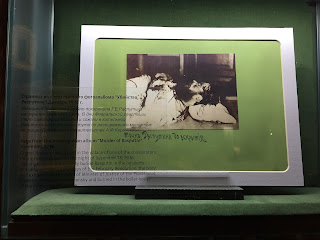181. State Museum of Political History of Russia
The State Museum of Political History of Russia is tucked away behind the Great Mosque on the Petrograd Side of St. Petersburg. It is housed in a historic mansion: the former residence of Matilda Kshesinskaya, a prima ballerina who was also the mistress of Emperor Nicholas II (the Tsesarevich at the time) at the start of the final decade of the nineteenth century, prior to Nicholas' marriage to Alexandra Feodorovna. The Kshesinskaya Palace, built in 1904, was the headquarters of the Bolsheviks a century ago. Vladimir Lenin frequently gave speeches to Petrograd's workers and soldiers from the balcony outside his second-floor office, between April and July of 1917. This was one of my favorite sections of the museum - walking in Lenin's footsteps really made history come alive.
Exhibits in this museum include "Man and Power in Russia in the 19th-21st Centuries", "The State Duma: Historical Parallels", "The Russian Revolution 1917-1922", "The Soviet Epoch: Between Utopia and Reality", and "Conscious Choice: Electoral Techniques and the Electorate". These exhibits are presented in roughly chronological sequence and cover the full range of the country's political history, from the Imperial period through the Revolution, the Soviet era, and modern Russian politics. Additional exhibits review the life of Kshesinskaya and the history of World Festivals of Youth and Students.
I was impressed with how unbiased most of the exhibits are; very little propaganda made its way into the presentation of historical information or interpretation of material culture. Various perspectives are included, and opposing viewpoints to the dominant narrative are mentioned throughout the museum. And the exhibits display a range of amazing objects that really helped me better understand where Russia has been and how it ended up where it is today. The subject matter can be a bit dry at times, so I recommend a visit only for adults who have a particular interest in political history (and don't mind reading lengthy text panels throughout the museum). But I've rarely been to history museums that surpass this one in scope or presentation.
Lenin's office and the balcony from which he made speeches:
Exhibits in this museum include "Man and Power in Russia in the 19th-21st Centuries", "The State Duma: Historical Parallels", "The Russian Revolution 1917-1922", "The Soviet Epoch: Between Utopia and Reality", and "Conscious Choice: Electoral Techniques and the Electorate". These exhibits are presented in roughly chronological sequence and cover the full range of the country's political history, from the Imperial period through the Revolution, the Soviet era, and modern Russian politics. Additional exhibits review the life of Kshesinskaya and the history of World Festivals of Youth and Students.
I was impressed with how unbiased most of the exhibits are; very little propaganda made its way into the presentation of historical information or interpretation of material culture. Various perspectives are included, and opposing viewpoints to the dominant narrative are mentioned throughout the museum. And the exhibits display a range of amazing objects that really helped me better understand where Russia has been and how it ended up where it is today. The subject matter can be a bit dry at times, so I recommend a visit only for adults who have a particular interest in political history (and don't mind reading lengthy text panels throughout the museum). But I've rarely been to history museums that surpass this one in scope or presentation.
Lenin's office and the balcony from which he made speeches:

























































Comments
Post a Comment